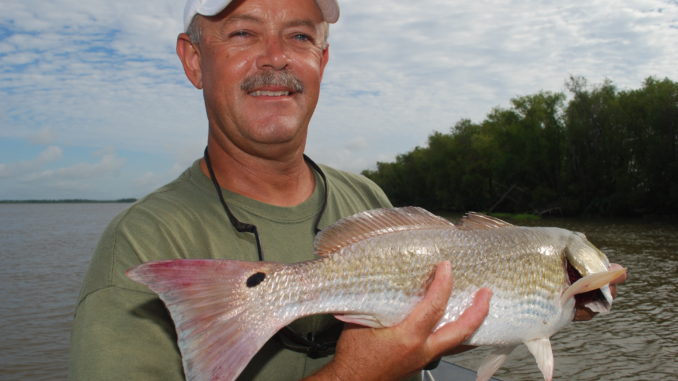
The Atchafalaya Delta holds plenty of redfish.
The Atchafalaya deltas are new marsh; two of the few places in Louisiana where new marsh is being built rather than lost. Older marshes are more complex places, where many years of pass and bayou formation, as well as subsidence, have created semi-impounded areas.
Tidal flux flushes water in and out of the ponds through small bayous and “drains.” Fishermen recognize those chokepoints as providing excellent redfish fishing on falling tides.
The Atchafalaya deltas provide few of these, primarily because the deltas are so youthful. Wax Lake Delta first emerged above water in 1973-74, and then it was only a single mudflat that emerged at low tide.
Consequently, fishing these marshes takes a reorientation of strategy. Most of the fishing is done in and around massive submerged aquatic plant beds. The plants, called pondweeds, belong to the genus Potomogeton. The species most common on the delta consists of 1- to 2-foot long strands and stems topped by lance-shaped leaves that float on the water’s surface at low tide.
They, along with duck potato and seed-bearing plants, are part of the flora complex that makes the Atchafalaya deltas so attractive to waterfowl. All ducks eat the soft and fleshy plants like we eat popcorn, but vegetation-eaters such as gadwall and wigeon find them especially attractive.
Any shallow water on the wax delta will hold patches of pondweed. But the outer extremities of the delta, where the passes pour their flow into the open waters of Atchafalaya Bay, are where vast beds of the plant lie. Typically, the plants grow most profusely on the sand bars that fringe the major passes, as well as the minor passes On high tide, with a foot or more of water in the beds, V-shaped wakes and splashes from predator fish striking baitfish, river shrimp and crabs are constant in the plants. Most of the activity is by redfish and blue catfish, some of the latter being supersized.
Unfortunately, the beds are so dense with plants that fishing in them is impossible, and anglers are confined to working their edges. Falling tides move fish to these edges, making more available to fishermen. Fishing during extreme low tides also makes fishing difficult because the plant beds are completely drained of water.
Some runout fishing on the wax delta does exist, primarily on the older, interior parts of the delta where some impounding has occurred. While such locations are much fewer in number than plant beds, they should never be overlooked because of the extraordinary fishing they can offer.
Editor’s note: This article is part of the Delta Dawn feature in the September issue of Louisiana Sportsman. Digital editions can be downloaded right to your computer or smartphone.
Be sure to subscribe to ensure you don’t miss a single information-packed issue of Louisiana Sportsman.